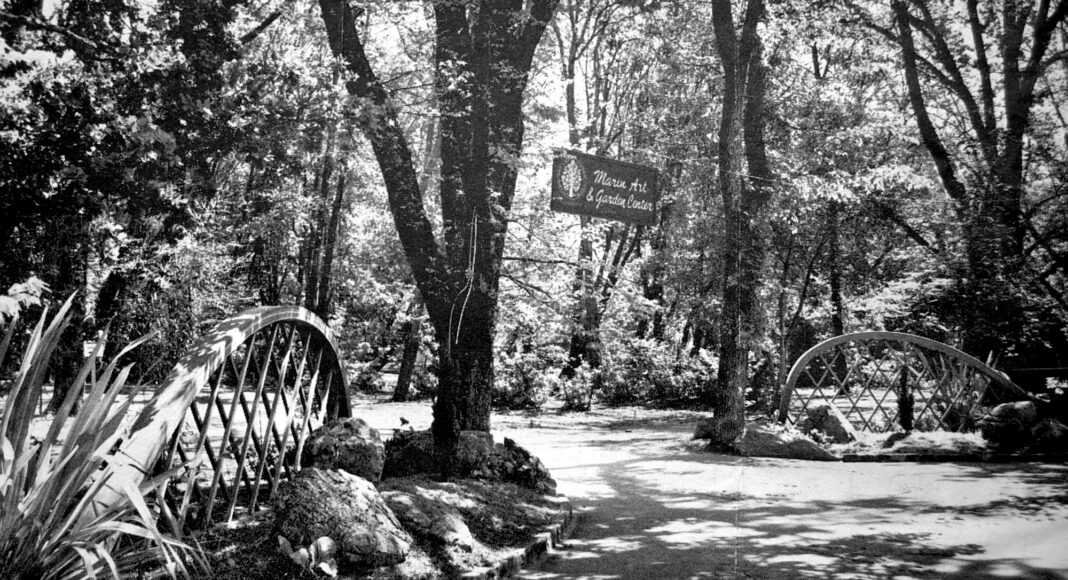Thanks to the foresight of a group of “Marin housewives” more than 75 years ago, the Marin Art and Garden Center in Ross was recently added to the National Register of Historic Places, an official list of America’s historic places worthy of preservation.
The center joins a prestigious collection of 53 landmark sites in the county on the National Register, including the Mount Tamalpais Mountain Theater, the Marin County Civic Center and the Green Brae Brick Kiln.
Although several of the buildings on the property are from the 19th century, the National Register listing is for the period from 1945 to 1962, with two main areas of significance: cultural history and design history, according to center executive director Antonia Adezio.
The cultural history started with the remarkable women referred to as “Marin housewives” in court documents. They were actually skilled environmentalists who founded garden and conservation organizations dedicated to saving Marin’s natural resources from development.
Due in large part to the efforts of the organizations’ founding members, including Caroline Livermore, Sepha Evers, Portia Forbes, Helen Van Pelt and Gladys Smith, the majority of Marin County remains predominantly open space. They worked on preserving Mount Tamalpais, Stinson Beach, Point Reyes and Angel Island. In addition, they spearheaded a campaign to ban billboards in Marin County, and the Board of Supervisors passed an ordinance in 1938 to remove all erected signs and prohibit new ones.
Also focused on preventing suburbanization in Marin, which started after the Golden Gate Bridge opened in 1936, Livermore and her partners may have been among the region’s first NIMBYs. They didn’t want the area populated with too many homes.
With development interest increasing, owners of Marin’s large estates and agricultural land began dividing their properties into smaller lots for new housing. When the lovely 11-acre Kittle estate in Ross was subdivided into more than a dozen parcels and put on the market, the women set their sights on preserving the property and keeping the estate buildings intact.
Livermore, who helped found the Marin Garden Club and the Marin Conservation League, used her own finances for the $5,000 down payment to purchase the estate, with its lush magnolia trees, a creek and several unique outbuildings that survived a fire responsible for burning the main house to the ground. Along with other members of the organizations, Livermore aimed to create a center for community use and provide a permanent place for garden and conservation clubs.
In 1945, the women accomplished their lofty goal of purchasing the Kittle property and setting up a nonprofit to run the Marin Art and Garden Center.
“What these women did was really brilliant,” Adezio said. “And they did it with very little resources, even putting their personal cash in to buy the estate. In Marin and across the United States, conservation-minded people banded together to try to save green and open space.”
The design history began in 1945, when the center’s board of trustees commissioned new buildings and landscaping and hired the leading architects in the Bay Area, including Gardner Dailey and Donn Emmons, of Wurster, Bernardi and Emmons, and landscape architects Thomas Church and Robert Royston.
“Each of them is significant in their own right,” Adezio said. “Their work is still here. The suite of buildings and the landscaping we have are intact.”
With World War II just ending, building materials were in short supply, which prompted simple designs in the Bay Region Modern–Second Bay Tradition. This local form of mid-century modern styling featured clean lines, glass walls and wood panels.
The application process for the listing on the National Register spanned about a year and a half; however, it took years to gather the documents and necessary information to put together a comprehensive narrative on why the center should be included.
Volunteers and staff worked diligently on securing the listing, which entailed interaction with three government agencies. The process began with the California Office of Historic Preservation, which helped the center’s supporters identify what they needed. Next, the State Historical Resources Commission reviewed the nomination to ensure that the site was eligible. Last October, the commission gave the green light. Finally, the United States Department of the Interior reviewed it and approved the listing on June 6.
And it may not have happened at all if a neighbor hadn’t gone dumpster diving.
Gary Scales, a neighbor and former trustee of the center, noticed a cleanup taking place on the property and items being thrown in the trash. When he stuck his head in the dumpster, he found some very important documents, including the meeting minutes from the period of significance in the National Register listing—1945 to 1962.
“How does that happen?” Adezio said. “With a nonprofit that’s had generations of people involved, the chain of command and memory is sometimes lost. People move on, things slip through the cracks. We were lucky Gary rescued it.”
The center’s history is rich, even if some of it isn’t included in the listing. The county fair took place on the property from 1946 to 1970. It began as the Marin Art and Garden Fair, which included arts and crafts displays, outdoor installations of gardens, archery contests and Uncle Sam walking around on stilts. The fair raised enough money to keep the Marin Art and Garden Center going.
Today, the center earns its keep in other ways, with a robust calendar for weddings and private events. A nature-inspired preschool is on the grounds, and a family-friendly summer concert series takes place every Thursday in July.
Over 100,000 people a year visit the center, which doesn’t charge admission. Folks stroll through the gardens, curl up on a bench with a book and play chess. On Aug. 3, the center’s 77th anniversary, there will be a celebration for the National Register listing. Details are not yet available.
“The listing gives us cause to celebrate and look at how we preserve the property,” Adezio said. “The Marin Art and Garden Center is a backyard for people.”











